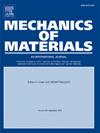晶体取向和加载条件对单晶铁微观结构演化和空穴演化动力学的影响:原子学研究
IF 4.1
3区 材料科学
Q2 MATERIALS SCIENCE, MULTIDISCIPLINARY
引用次数: 0
摘要
为了在宏观尺度上预测小块断裂,需要对孔隙演化动力学的理解,以开发/改进高应变速率下的断裂模型。通过分子动力学模拟,探讨了晶体取向和加载条件对单晶铁微观结构演化和空穴演化动力学的影响。我们发现所有晶体取向的情况下都表现出与实验一致的结构转变。孔洞的成核和生长对外加载荷条件和晶体取向敏感。单轴变形时孔洞生长为主,三轴变形时孔洞成核为主。三轴变形下,峰值拉伸压力、组织转变量和整体孔隙体积分数对晶体取向不敏感,而在单轴和双轴变形下,它们对晶体取向敏感。位错的演化、孔洞的数量和孔洞的尺寸分布都对外加载荷条件和晶体取向非常敏感。一小部分空隙占了空隙总体积的大部分。本文章由计算机程序翻译,如有差异,请以英文原文为准。
Role of crystal orientations and loading conditions on the microstructure evolution and void evolution dynamics in single crystal iron: An atomistic investigation
An understanding of void evolution dynamics is required to develop/improve fracture models at a high strain rate to predict spall fracture at the macroscale. We perform molecular dynamics simulations to explore the role of crystal orientations and loading conditions on the microstructure evolution and void evolution dynamics in single-crystal iron. We find that all the cases of crystal orientations show structural transformations consistent with experiments. The dominance of the nucleation and growth of voids is sensitive to the applied loading conditions and crystal orientations. Void growth dominates under uniaxial deformation, and void nucleation dominates under triaxial deformation. Peak tensile pressure, the amount of structural transformation, and overall void volume fraction are insensitive to the crystal orientations under triaxial deformation, while they are susceptible under uniaxial and biaxial deformations. The dislocation evolution, number of voids, and size distributions of voids are all very sensitive to the applied loading conditions and crystal orientations. A small percentage of voids accounts for the majority of the total volume of the voids.
求助全文
通过发布文献求助,成功后即可免费获取论文全文。
去求助
来源期刊

Mechanics of Materials
工程技术-材料科学:综合
CiteScore
7.60
自引率
5.10%
发文量
243
审稿时长
46 days
期刊介绍:
Mechanics of Materials is a forum for original scientific research on the flow, fracture, and general constitutive behavior of geophysical, geotechnical and technological materials, with balanced coverage of advanced technological and natural materials, with balanced coverage of theoretical, experimental, and field investigations. Of special concern are macroscopic predictions based on microscopic models, identification of microscopic structures from limited overall macroscopic data, experimental and field results that lead to fundamental understanding of the behavior of materials, and coordinated experimental and analytical investigations that culminate in theories with predictive quality.
 求助内容:
求助内容: 应助结果提醒方式:
应助结果提醒方式:


